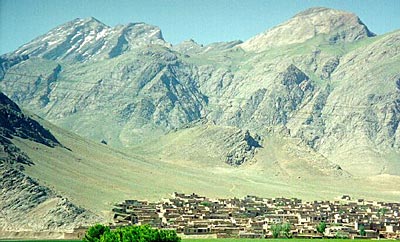

GEOGRAPHICAL BOUNDARIES
includes present-day countries of Turkey, Iraq, Iran, Saudi Arabia,
Israel, Lebanon, Syria, Jordan, plus the adjacent small countries and
some
former USSR provinces
areas include Anatolia, the Arabian peninsula, Persia, and the
Iranian
Plateau
bounded by Mediterranean Sea in west, the Arabian Sea and Red Sea
in south, Black Sea in north, Pakistan/Afghanistan in east

Map of present-day countries in the
Near East.
TOPOGRAPHY
fundamental dichotomy is highlands and lowlands, with highlands corresponding to mountain ranges and high-elevation plateaus and lowlands corresponding to hills and plains at low elevation
both have tectonically active areas (earthquakes especially)

Highlands (brown) and lowlands
(green) in the Near
East.
MOUNTAIN RANGES
two major ranges of Anatolia are Pontic and Taurus
two major ranges of Iran are Zagros and Elburz, but there are others
two major uplands are Anatolian Plateau and Iranian Plateau, both
of which are ringed by mtns, dry, and at 500-1500 m elevations
traits of major ranges: 2000 m tree line, peaks over 2500 m,
alluvial valleys between ranges

View of the Zagros Mountains in Iraq.
SOUTHERN HILLS AND PLAINS
topographically diverse, with hills, low mountains up to 1000 m in
elevation, valleys
most bedrock is sedimentary
major features is Tigris-Euphrates river valley or Mesopotamia
(Greek
for "land between two rivers"): tectonically unstable area,
alluvium
infilling flattened surface over folded bedrock
Levant area: tectonically deformed and active, disjointed
nature
of landscape and landscape features (narrow coast, mountains, desert)
inhibited
political unification in prehistory so only city-states developed

Mesopotamia is shaded in yellow.
CLIMATE
regional climate is Mediterranean regime
local climate regimes influenced by several factors: latitude,
topography, landforms, flora
favorable for agriculture despite extremes
lowland climate characterized by hot summers, broad annual and
diurnal
temperature ranges, snow possible everywhere but Saudi Arabia, unstable
rainfall amounts but most in winter
highland climate characterized by stable rainfall levels, summer crops possible
ENVIRONMENTAL ZONES
1. coastal plains - little archaeological research here
2. alluvial plains - marshy when flood, two seasons
3. piedmont - transitional zone between lowlands and highlands
4. semiarid highlands - example is the Jezireh plain, a very dry
grassland
5. foothills and intermontane valleys - "hilly flanks," dry farming
possible, trees gone now
6. mountain ranges - four major ranges surrounding two major
plateaus
7. depressions - may be tectonic
8. deserts - in uplands and the entire Arabian peninsula
VEGETATION
very important in patterns of human population distributions
five factors affect nature of floral communities: climate,
topography,
soil, phytogeographic regions where ancestors were found), human
activity
current evidence indicates farming may have begun in areas where
early
domesticates were native, then it spread as technology developed
five vegetation zones:
1. Mediterranean vegetation: - open woodlands
2. steppe vegetation - savanna vegetation with shrubs and
±
trees
3. mountain vegetation - composition depends on elevation,
deciduous
and coniferous trees
4. riverine vegetation - willow, palm, poplar, grasses,
reeds,
etc
5. desert vegetation - sparse grasses and scrub
HUMAN IMPACT ON ENVIRONMENT
longest history and best documented case of environmental
degradation
in world, over 10,000 years
history of intensive use and mismanagement of resources
environment today is much more hostile than was in past
most negative effects related to food production and wood resource
needs for shelters and fuel
effects of food production on environment:
1. overgrazing and poor farming practices led to soil
erosion,
especially widespread on slopes
2. overgrazing and poor farming practices depleted vast
grasslands
3. extinction or serious depletion of wild game and plants,
especially in foothills regions
4. soil salinization resulting from overirrigation and
inadequate
drainage, especially in Sumer area
where there is currently
little to no habitation but urban centers once loomed (after 3500 BC)
Soil salinization.
SUMMARY: POSITIVES AND NEGATIVES
POSITIVE FEATURES
1. complex waterways (water for irrigation, navigable for
transportation)
2. fertile soil in prehistory so good crop production, even
surpluses
(if watered)
3. wild food resources in prehistory, including presence of
domesticate
progenitors
4. abundant farmland in early prehistory
5. productivity in prehistory was very high, was comparable to
current
Canadian wheat agriculture
6. abundant natural resources (often a source of wealth)
NEGATIVE FEATURES
1. low rainfall so dry agriculture not feasible in most places
2. natural resources are unevenly distributed, and there is little
raw material for tools and building, so trade was very important
3. unpredictable flooding along Tigris and Euphrates, especially at
critical farming times (harvest, plant)
4. temperature extremes (hot summer, cold winter)
5. became an increasingly degraded environment over time, largely due to human activities
REFERENCE
Redman, Charles L.
1978 The Rise of Civilization. W.H. Freeman, San
Fransisco.
To view sources
of images reproduced on this web page, left click on the image and
select Properties.
The URL is
listed under Alternate Text.